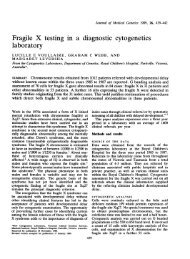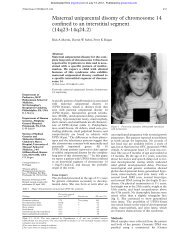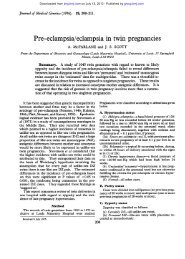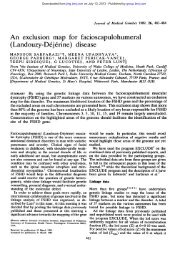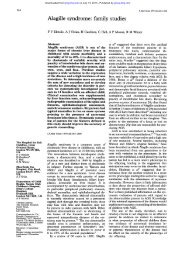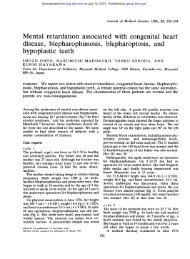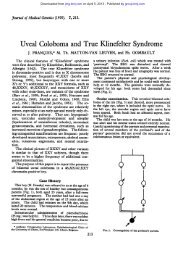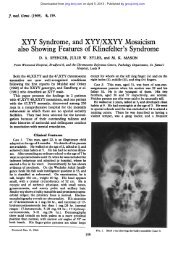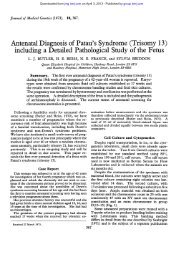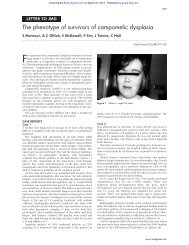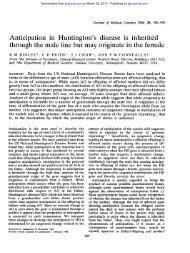Cornelia de Lange syndrome in several members of the same family
Cornelia de Lange syndrome in several members of the same family
Cornelia de Lange syndrome in several members of the same family
Create successful ePaper yourself
Turn your PDF publications into a flip-book with our unique Google optimized e-Paper software.
Downloa<strong>de</strong>d from<br />
jmg.bmj.com on March 29, 2013 - Published by group.bmj.com<br />
Journal <strong>of</strong> Medical Genetics 1985, 22, 296-300<br />
<strong>Cornelia</strong> <strong>de</strong> <strong>Lange</strong> <strong>syndrome</strong> <strong>in</strong> <strong>several</strong> <strong>members</strong> <strong>of</strong><br />
<strong>the</strong> <strong>same</strong> <strong>family</strong><br />
D KUMAR*, C E BLANK*, AND B L GRIFFITHSt<br />
From *<strong>the</strong> Centre for Human Genetics, 117 Manchester Road, Sheffield; and tNeath General Hospital,<br />
Neath, Glamorgan.<br />
SUMMARY A <strong>family</strong> is reported <strong>in</strong> which <strong>several</strong> <strong>members</strong> have <strong>the</strong> <strong>Cornelia</strong> <strong>de</strong> <strong>Lange</strong> <strong>syndrome</strong><br />
and o<strong>the</strong>r <strong>members</strong> show facial dysmorphism and o<strong>the</strong>r features rem<strong>in</strong>iscent <strong>of</strong> this <strong>syndrome</strong>.<br />
The segregation pattern is consistent with <strong>the</strong> view that <strong>the</strong> dysmorphic features (variable) are <strong>the</strong><br />
manifestation <strong>of</strong> a s<strong>in</strong>gle gene <strong>in</strong> heterozygous form. Chromosome abnormality was not found.<br />
In 1933 <strong>Cornelia</strong> <strong>de</strong> <strong>Lange</strong>, a dist<strong>in</strong>guished Dutch<br />
paediatrician, <strong>de</strong>scribed two unrelated <strong>in</strong>fant girls'<br />
with a <strong>syndrome</strong> characterised by mental retardation<br />
and physical anomalies <strong>in</strong>volv<strong>in</strong>g face and<br />
limbs. 1 Brachmann had reported a similar condition<br />
from Amsterdam <strong>in</strong> 1916. Opitz et al3 suggested <strong>the</strong><br />
<strong>syndrome</strong> be <strong>de</strong>signated <strong>the</strong> Brachmann-<strong>de</strong> <strong>Lange</strong><br />
<strong>syndrome</strong>. It is also known as 'Amsterdam dwarfism'.<br />
Reports have appeared from various parts <strong>of</strong><br />
<strong>the</strong> world and <strong>in</strong> 1970 about 250 examples were on<br />
record.4 The aetiology <strong>of</strong> this dysmorphic <strong>syndrome</strong><br />
is not clear. Although it is familial <strong>the</strong> condition has<br />
not been shown to have a characteristic pedigree<br />
pattern.<br />
The card<strong>in</strong>al features <strong>of</strong> <strong>the</strong> <strong>Cornelia</strong> <strong>de</strong> <strong>Lange</strong><br />
<strong>syndrome</strong>5 are short stature, mental retardation,<br />
microbrachycephaly, bushy eyebrows, synophrys,<br />
long curly eye lashes, small nose, anteverted nostrils,<br />
characteristic lips and mouth, high arched<br />
palate, micrognathia, hirsutism, and small hands<br />
and feet with brachydactyly. About 20(% <strong>of</strong> patients<br />
have seizures. IQ varies from 40 to 85. Occasional<br />
anomalies are myopia, microcornea, astigmatism,<br />
optic atrophy, coloboma <strong>of</strong> <strong>the</strong> optic nerve, strabismus,<br />
proptosis, choanal atresia, low set ears, cleft<br />
palate, congenital heart <strong>de</strong>fect (most commonly<br />
ventricular septal <strong>de</strong>fect), hiatus hernia, pyloric<br />
stenosis, brachyoesophagus, and un<strong>de</strong>scen<strong>de</strong>d<br />
testes. Dermatoglyphic f<strong>in</strong>d<strong>in</strong>gs <strong>in</strong>clu<strong>de</strong> absence <strong>of</strong><br />
<strong>the</strong> second or third or both <strong>in</strong>terdigital triradii on <strong>the</strong><br />
hands.<br />
We report a <strong>family</strong> <strong>in</strong> which <strong>several</strong> <strong>members</strong><br />
have been recognised to have <strong>the</strong> <strong>Cornelia</strong> <strong>de</strong> <strong>Lange</strong><br />
<strong>syndrome</strong> and o<strong>the</strong>r <strong>members</strong> have an odd facial<br />
appearance and o<strong>the</strong>r features rem<strong>in</strong>iscent <strong>of</strong> this<br />
<strong>syndrome</strong>.<br />
Received for publication 6 Septcmber 1984.<br />
Accepted for publication 12 October 1984.<br />
Family history and case reports<br />
The consultand (fig 1, 111.27), aged 24 years, was<br />
referred to <strong>the</strong> Centre for Human Genetics, Sheffield,<br />
for genetic counsell<strong>in</strong>g because her bro<strong>the</strong>r<br />
(III.26) had been diagnosed as hav<strong>in</strong>g <strong>the</strong> features<br />
<strong>of</strong> <strong>the</strong> <strong>Cornelia</strong> <strong>de</strong> <strong>Lange</strong> <strong>syndrome</strong>. Her mo<strong>the</strong>r<br />
(11.7) had had five children. The first male <strong>in</strong>fant<br />
(111.28), born at 36 weeks' gestation and who died <strong>in</strong><br />
<strong>the</strong> neonatal period, had a large head, odd facies,<br />
and abnormal feet. The significance <strong>of</strong> <strong>the</strong>se abnormalities<br />
to <strong>the</strong> diagnosis <strong>of</strong> <strong>Cornelia</strong> <strong>de</strong> <strong>Lange</strong><br />
<strong>syndrome</strong> is unclear. Ano<strong>the</strong>r male <strong>in</strong>fant (III.30),<br />
who died at 31/2 months <strong>of</strong> age due to respiratory<br />
illness associated with a heart <strong>de</strong>fect, had been<br />
<strong>de</strong>signated an example <strong>of</strong> <strong>the</strong> <strong>Cornelia</strong> <strong>de</strong> <strong>Lange</strong><br />
<strong>syndrome</strong> by a different paediatrician from that<br />
exam<strong>in</strong><strong>in</strong>g 111.26. There was no consangu<strong>in</strong>ity <strong>in</strong><br />
ei<strong>the</strong>r marriage. Both her husbands were phenotypically<br />
normal. The mo<strong>the</strong>r (11.7) has features consistent<br />
with <strong>the</strong> diagnosis <strong>of</strong> <strong>the</strong> <strong>Cornelia</strong> <strong>de</strong> <strong>Lange</strong><br />
<strong>syndrome</strong>. Her two daughters (111.27 and 111.29) are<br />
without significant stigmata. One <strong>of</strong> her sisters (11.5)<br />
is reported to have a strong facial resemblance to<br />
her and to be <strong>of</strong> short stature and <strong>of</strong> low <strong>in</strong>telligence.<br />
That sister has had a number <strong>of</strong> pregnancies<br />
but only four daughters are alive. Two <strong>of</strong> <strong>the</strong>m<br />
(111.19 and 111.25) are reported to be mentally<br />
retar<strong>de</strong>d with an abnormal facial appearance. One<br />
<strong>of</strong> <strong>the</strong>m (111.25) had been diagnosed by one <strong>of</strong> <strong>the</strong><br />
authors (BLG), without knowledge <strong>of</strong> previous<br />
assessments, as hav<strong>in</strong>g <strong>the</strong> <strong>Cornelia</strong> <strong>de</strong> <strong>Lange</strong><br />
<strong>syndrome</strong>. She is one <strong>of</strong> tw<strong>in</strong>s and <strong>the</strong> o<strong>the</strong>r tw<strong>in</strong><br />
was a macerated stillbirth. A sixth pregnancy<br />
resulted <strong>in</strong> a stillbirth (111.20) and a seventh <strong>in</strong> an<br />
early neonatal <strong>de</strong>ath (111.21). Both <strong>the</strong>se babies<br />
were reported to have had a similar facial appearance<br />
to 111.25. 11.1 is reported to have had a<br />
296
<strong>Cornelia</strong> <strong>de</strong> <strong>Lange</strong> <strong>syndrome</strong> <strong>in</strong> <strong>several</strong> <strong>members</strong> <strong>of</strong> <strong>the</strong> <strong>same</strong> <strong>family</strong><br />
II 11(2 3 4 6<br />
12 345 1 5 1 18 219 19<br />
262728<br />
m ,0 00,<br />
]0Q Normol 3 Reported to hove features rem<strong>in</strong>iscent<br />
*@ Comelia <strong>de</strong> <strong>Lange</strong> <strong>of</strong> <strong>Cornelia</strong> <strong>de</strong> <strong>Lange</strong> <strong>syndrome</strong><br />
synidrome Probancd<br />
FIG 1 Pedigree show<strong>in</strong>g <strong>the</strong> affected and possibly affected subjects with <strong>the</strong> <strong>Cornelia</strong> <strong>de</strong> <strong>Lange</strong> <strong>syndrome</strong>.<br />
congenital heart <strong>de</strong>fect although she died aged 55<br />
years. 11.2 and 11.3 are said to be normal with a<br />
number <strong>of</strong> healthy <strong>of</strong>fspr<strong>in</strong>g (111.1 to 16). The<br />
grandmo<strong>the</strong>r (1.2) was also reported to be <strong>of</strong> short<br />
stature with odd facial features, short and stubby<br />
f<strong>in</strong>gers, and small feet with webbed toes.<br />
Case reports<br />
Downloa<strong>de</strong>d from<br />
jmg.bmj.com on March 29, 2013 - Published by group.bmj.com<br />
The proband (III.26, fig 2), aged 28 years, was born<br />
on 27.8.57 follow<strong>in</strong>g a normal <strong>de</strong>livery after a 41<br />
week gestation. The birth weight was 2750 g. Physical<br />
exam<strong>in</strong>ation revealed a small male <strong>in</strong>fant with<br />
peculiar facies. At 18 months <strong>of</strong> age he had a<br />
strangulated hernia which required surgical treatment.<br />
A diagnosis <strong>of</strong> <strong>the</strong> <strong>Cornelia</strong> <strong>de</strong> <strong>Lange</strong> <strong>syndrome</strong><br />
was ma<strong>de</strong> <strong>in</strong> 1963. His general health has<br />
been good, apart from occasional respiratory <strong>in</strong>fections.<br />
The right testicle has never been palpable.<br />
The left required surgical placement <strong>in</strong> <strong>the</strong> scrotum.<br />
He had faecal <strong>in</strong>cont<strong>in</strong>ence up to <strong>the</strong> age <strong>of</strong> 5 years.<br />
His growth has been generally slow; his weight at 6<br />
months was 5-2 kg and at 1 year just over 6 kg, with<br />
a crown-heel length <strong>of</strong> 66 cm (below <strong>the</strong> 3rd centile)<br />
and a head circumference <strong>of</strong> 43 cm (below <strong>the</strong> 3rd<br />
centile). The bone age at 5 years 3 months was<br />
FIG 2 The proband show<strong>in</strong>g <strong>the</strong> characteristic facial<br />
appearance <strong>of</strong> <strong>the</strong> <strong>Cornelia</strong> <strong>de</strong> <strong>Lange</strong> <strong>syndrome</strong>.<br />
297
298<br />
Downloa<strong>de</strong>d from<br />
jmg.bmj.com on March 29, 2013 - Published by group.bmj.com<br />
FIG 3 Small hands, short stubbyf<strong>in</strong>gers, and cl<strong>in</strong>odactyly <strong>of</strong><br />
<strong>the</strong> fifth f<strong>in</strong>ger <strong>of</strong> <strong>the</strong> proband.<br />
estimated to be at 41 months. His height at 13 years<br />
was 122 cm and weight 22 kg. His <strong>de</strong>velopment has<br />
been retar<strong>de</strong>d <strong>in</strong> all directions. An <strong>in</strong>telligence<br />
assessment at 5 years 5 months (Terman-Merril<br />
scale) gave an IQ <strong>of</strong> 43 and at 6 years 11 months 36.<br />
He now attends a tra<strong>in</strong><strong>in</strong>g centre. He has bilateral<br />
<strong>in</strong>termittent <strong>de</strong>afness.<br />
At 25 years <strong>of</strong> age, physical exam<strong>in</strong>ation revealed<br />
a small man who appeared to be mentally subnormal<br />
with hirsutism. The eyebrows (fig 2) were confluent<br />
<strong>in</strong> <strong>the</strong> centre <strong>of</strong> <strong>the</strong> forehead form<strong>in</strong>g a triangular<br />
shaped area. An antimongoloid slant was quite<br />
marked and <strong>the</strong> eyelashes were long and abundant.<br />
.<br />
*:<br />
:X,<br />
:i.<br />
:-<br />
D Kulmiar, C E Blatnk, antid B L Griffiths<br />
The frontal hair l<strong>in</strong>e was encroach<strong>in</strong>g <strong>the</strong> forehead,<br />
which was small. The nose was long and beaky and<br />
<strong>the</strong> upper lip was th<strong>in</strong> and down-turned with a long<br />
philtrum. The palate was high arched and <strong>the</strong>re was<br />
marked micrognathia. The ears were large, malformed,<br />
low set, and posteriorly rotated. The hands<br />
were small, <strong>the</strong> palms were square, and <strong>the</strong> f<strong>in</strong>gers<br />
were short and stubby (fig 3). There was cl<strong>in</strong>odactyly<br />
<strong>of</strong> <strong>the</strong> little f<strong>in</strong>gers <strong>of</strong> both hands. Both feet<br />
showed forefoot abduction, hallux valgus, and<br />
overrid<strong>in</strong>g third and fourth toes (fig 4). The neck was<br />
short, with a low posterior hair l<strong>in</strong>e. However, <strong>the</strong>re<br />
was no radiological evi<strong>de</strong>nce <strong>of</strong> any cervical sp<strong>in</strong>e<br />
anomaly. The genitalia were not fully <strong>de</strong>veloped and<br />
only <strong>the</strong> left testicle could be felt, high up <strong>in</strong> <strong>the</strong><br />
scrotum. Dermatoglyphs did not show any abnormal<br />
pattern. Cytogenetic studies (prometaphase band<strong>in</strong>g)<br />
confirmed a normal male chromosome<br />
complement.<br />
The mo<strong>the</strong>r (11.7) <strong>of</strong> <strong>the</strong> proband was also<br />
exam<strong>in</strong>ed by one <strong>of</strong> <strong>the</strong> authors (DK). She was short<br />
statured (height 151 cm) with small hands and short<br />
stubby f<strong>in</strong>gers. She had facial features consistent<br />
with <strong>the</strong> diagnosis <strong>of</strong> <strong>the</strong> <strong>Cornelia</strong> <strong>de</strong> <strong>Lange</strong> <strong>syndrome</strong>,<br />
but she appeared to be mentally normal.<br />
Dermatoglyphs were not unusual. Cytogenetic studies<br />
revealed a normal female chromosome complement.<br />
One <strong>of</strong> <strong>the</strong> cous<strong>in</strong>s <strong>of</strong> <strong>the</strong> proband (111.25)<br />
was exam<strong>in</strong>ed by one <strong>of</strong> <strong>the</strong> authors (BLG). She was<br />
born on 22.2.72 and weighed 1-5 kg at birth which<br />
was at 30 to 32 weeks' gestation. She had a stormy<br />
neonatal period and was very slow to take feeds. She<br />
progressed very slowly and rema<strong>in</strong>ed <strong>in</strong> <strong>the</strong> neonatal<br />
nursery up to <strong>the</strong> age <strong>of</strong> 6 months. Her subsequent<br />
<strong>de</strong>velopment was very slow. Her physical growth<br />
has been markedly retar<strong>de</strong>d (height and weight<br />
below <strong>the</strong> 3rd centile). She showed <strong>the</strong> characteristic<br />
facies <strong>of</strong> <strong>Cornelia</strong> <strong>de</strong> <strong>Lange</strong> <strong>syndrome</strong> (fig 5) with<br />
FIG 4 Proband's feet show<strong>in</strong>g forefoot abduction, hallux<br />
valgus, and overrid<strong>in</strong>g third and fourth toes. FIG 5 Characteristic facial appearance <strong>of</strong> 111.25.
Downloa<strong>de</strong>d from<br />
jmg.bmj.com on March 29, 2013 - Published by group.bmj.com<br />
<strong>Cornelia</strong> <strong>de</strong> <strong>Lange</strong> <strong>syndrome</strong> <strong>in</strong> <strong>several</strong> <strong>members</strong> <strong>of</strong> <strong>the</strong> <strong>same</strong> <strong>family</strong><br />
FIG6 Smallhandsandshort stubbyf<strong>in</strong>gers<strong>of</strong>11125.<br />
small hands and feet (fig 6). She was severely <strong>de</strong>af<br />
and wore a hear<strong>in</strong>g aid. She was only able to<br />
communicate by means <strong>of</strong> very basic speech but,<br />
however, she could communicate well us<strong>in</strong>g <strong>the</strong><br />
FIG 7 Family photograph. From top left: normal sister <strong>of</strong><br />
<strong>the</strong> proband (III.29), mo<strong>the</strong>r (II. 7) with facialfeatures <strong>of</strong><br />
<strong>the</strong> <strong>Cornelia</strong> <strong>de</strong> <strong>Lange</strong> <strong>syndrome</strong>, and <strong>the</strong> consultand<br />
(III.27). In <strong>the</strong> middle from left: aunt (11.5), show<strong>in</strong>g facial<br />
resemblance to <strong>the</strong> mo<strong>the</strong>r, and her daughter (111.25) with a<br />
similar facial appearance. From bottom left: cous<strong>in</strong> (III. 19)<br />
with similar facial appearance to <strong>the</strong> proband (III. 26).<br />
Makaton sign language. Her learn<strong>in</strong>g age at 11 years<br />
7 months was 8 years and <strong>the</strong> V<strong>in</strong>eland Social<br />
Maturity Scale gave her a social age <strong>of</strong> 5-5 years. She<br />
now attends a partial hear<strong>in</strong>g unit <strong>in</strong> <strong>the</strong> school.<br />
Cytogenetic studies on 111.25 revealed a normal<br />
female chromosome complement. A <strong>family</strong> photograph<br />
is shown <strong>in</strong> fig 7.<br />
Discussion<br />
299<br />
Many aspects <strong>of</strong> <strong>the</strong> <strong>Cornelia</strong> <strong>de</strong> <strong>Lange</strong> <strong>syndrome</strong><br />
have been recognised s<strong>in</strong>ce <strong>the</strong> orig<strong>in</strong>al <strong>de</strong>scription<br />
by <strong>de</strong> <strong>Lange</strong> <strong>in</strong> 1933,' but familial cases are very few<br />
and no clear pedigree pattern is evi<strong>de</strong>nt. Although<br />
chromosome irregularity has been observed,6<br />
abnormality is <strong>in</strong>consistent and probably<br />
co<strong>in</strong>ci<strong>de</strong>ntal.7 Similar cl<strong>in</strong>ical features have been<br />
observed <strong>in</strong> children with partial trisomy<br />
3q (3q21-+qter) and compared with those hav<strong>in</strong>g <strong>the</strong><br />
<strong>Cornelia</strong> <strong>de</strong> <strong>Lange</strong> <strong>syndrome</strong>.8 Heterogeneity <strong>of</strong><br />
orig<strong>in</strong> seems a likely possibility. There is no previous<br />
recor<strong>de</strong>d case <strong>of</strong> a patient with clear cut <strong>Cornelia</strong> <strong>de</strong><br />
<strong>Lange</strong> <strong>syndrome</strong> hav<strong>in</strong>g an affected child, although<br />
Borghi et afi and Beer et all" reported families <strong>in</strong><br />
which a parent <strong>of</strong> an affected child is said to have<br />
had m<strong>in</strong>or manifestations. It must, however, be<br />
recalled that <strong>the</strong> physical and mental limitations<br />
imposed upon <strong>the</strong>se patients by <strong>the</strong> condition make<br />
reproduction unlikely.4 Borghi et at' suggested<br />
dom<strong>in</strong>ant <strong>in</strong>heritance and Opitz"l thought <strong>the</strong> condition<br />
to be '<strong>in</strong>completely recessive'. Autosomal<br />
dom<strong>in</strong>ant <strong>in</strong>heritance is also discussed by McArthur<br />
and Edwards. 12 Although only three abnormal<br />
persons <strong>in</strong> <strong>the</strong> <strong>family</strong> <strong>de</strong>scribed <strong>in</strong> this report were<br />
actually exam<strong>in</strong>ed by <strong>the</strong> present authors, <strong>the</strong><br />
cl<strong>in</strong>ical features exhibited fit <strong>the</strong> <strong>Cornelia</strong> <strong>de</strong> <strong>Lange</strong><br />
<strong>syndrome</strong> well. A half bro<strong>the</strong>r <strong>of</strong> <strong>the</strong> proband was<br />
<strong>in</strong><strong>de</strong>pen<strong>de</strong>ntly <strong>de</strong>signated as an example <strong>of</strong> this<br />
condition. His grandmo<strong>the</strong>r and one maternal aunt<br />
have stigmata rem<strong>in</strong>iscent <strong>of</strong> this <strong>syndrome</strong>. It is<br />
reasonable to suggest that <strong>the</strong> features observed <strong>in</strong><br />
all <strong>the</strong>se affected persons are manifestations <strong>of</strong> <strong>the</strong><br />
<strong>same</strong> genetic <strong>de</strong>fect. This condition is clearly segregat<strong>in</strong>g<br />
<strong>in</strong> this <strong>family</strong> as a dom<strong>in</strong>ant trait with variable<br />
expression.<br />
The authors thank Mrs Edna Maltby, Senior Scientific<br />
Officer, for perform<strong>in</strong>g <strong>the</strong> cytogenetic studies.<br />
We are grateful to <strong>the</strong> Department <strong>of</strong> Medical<br />
Illustration, Royal Hallamshire Hospital, Sheffield,<br />
for <strong>the</strong> photographs. This paper could not have been<br />
completed without <strong>the</strong> generous cooperation <strong>of</strong> <strong>the</strong><br />
<strong>family</strong> <strong>members</strong>.
300<br />
Downloa<strong>de</strong>d from<br />
jmg.bmj.com on March 29, 2013 - Published by group.bmj.com<br />
References<br />
Dc <strong>Lange</strong> C. Sur un type nouveau <strong>de</strong> <strong>de</strong>generation (typus<br />
amsteldoamensis). Arch Med Enf 1933;36:713-9.<br />
2 Bishun NP, Morton WRM. Brachmann-<strong>de</strong> <strong>Lange</strong> <strong>syndrome</strong>.<br />
Lancet 1965 ;i:439.<br />
3 Opitz JM, Segal AT, Lehrke R, Nadler H. Brachmann-<strong>de</strong><br />
<strong>Lange</strong> <strong>syndrome</strong>. Lancet 1964;ii: 1019.<br />
4 Berg JM, McCreary BD, Ridler MAC, Smith GF. The <strong>de</strong> <strong>Lange</strong><br />
<strong>syndrome</strong>. Oxford: Pergamon Press, 1970.<br />
5 Smith DW. Recognizable patterns <strong>of</strong> human malformation. 3rd<br />
ed. Phila<strong>de</strong>lphia: Saun<strong>de</strong>rs, 1982:76-7.<br />
h Broholm KA, Eeg-Ol<strong>of</strong>sson 0, Hall B. An <strong>in</strong>herited chromosome<br />
aberration <strong>in</strong> a girl with signs <strong>of</strong> <strong>de</strong> <strong>Lange</strong> <strong>syndrome</strong>. Atta<br />
Paediatr Scanid 1968;57:547-52.<br />
7 Beratis NG, Hsu LYF, Hirschhorn K. Familial <strong>de</strong> <strong>Lange</strong><br />
<strong>syndrome</strong>: report <strong>of</strong> three cases <strong>in</strong> a sibship. Cl<strong>in</strong> Genet<br />
1971 ;2: 17(-6.<br />
Borgaonkar DS, ed. 3q partial trisomy <strong>syndrome</strong>. In: Chromo-<br />
D Kumar, C E Blank, and B L Griffiths<br />
somal variation <strong>in</strong> man. 3rd ed, appendix 11/651. New York:<br />
Alan R Liss, 1977.<br />
9Borghi A, Glusti G, Biogozzi U. Nanismo <strong>de</strong>generative tipo di<br />
Amsterdam (typus amstelodamensis-malatia di <strong>Cornelia</strong> <strong>de</strong><br />
<strong>Lange</strong>). Prezentazione di un caso e consi<strong>de</strong>razioni di ord<strong>in</strong>e<br />
genetico. Acta Genet Med (Roma) 1954;3:365-72.<br />
1 Beer S, Wallis K, Czerniak P. Two cases <strong>of</strong> De <strong>Lange</strong>'s<br />
<strong>syndrome</strong> (typus amstelodamensis <strong>de</strong>generativus). J Ment Defic<br />
Res 1968;12:128-37.<br />
1Opitz JM. Editorial comments on <strong>the</strong> etiology <strong>of</strong> <strong>the</strong> <strong>Cornelia</strong> <strong>de</strong><br />
<strong>Lange</strong> <strong>syndrome</strong>. In: Year Book <strong>of</strong> Pediatrics. Chicago: Year<br />
Book Medical Publishers, 1964-1965 series: 499-504.<br />
12 McArthur RG, Edwards JH. De <strong>Lange</strong> <strong>syndrome</strong>: report <strong>of</strong> 20<br />
cases. Can Med Assoc J 1967;%:1185-98.<br />
Correspon<strong>de</strong>nce and requests for repr<strong>in</strong>ts to Dr D<br />
Kumar, Centre for Human Genetics, 117 Manchester<br />
Road, Sheffield S10 5DN.
Downloa<strong>de</strong>d from<br />
jmg.bmj.com on March 29, 2013 - Published by group.bmj.com<br />
Email alert<strong>in</strong>g<br />
service<br />
Notes<br />
<strong>Cornelia</strong> <strong>de</strong> <strong>Lange</strong> <strong>syndrome</strong> <strong>in</strong><br />
<strong>several</strong> <strong>members</strong> <strong>of</strong> <strong>the</strong> <strong>same</strong><br />
<strong>family</strong>.<br />
D Kumar, C E Blank and B L Griffiths<br />
J Med Genet 1985 22: 296-300<br />
doi: 10.1136/jmg.22.4.296<br />
Updated <strong>in</strong>formation and services can be found at:<br />
http://jmg.bmj.com/content/22/4/296<br />
These <strong>in</strong>clu<strong>de</strong>:<br />
To request permissions go to:<br />
http://group.bmj.com/group/rights-licens<strong>in</strong>g/permissions<br />
To or<strong>de</strong>r repr<strong>in</strong>ts go to:<br />
http://journals.bmj.com/cgi/repr<strong>in</strong>tform<br />
To subscribe to BMJ go to:<br />
http://group.bmj.com/subscribe/<br />
Receive free email alerts when new articles cite this<br />
article. Sign up <strong>in</strong> <strong>the</strong> box at <strong>the</strong> top right corner <strong>of</strong><br />
<strong>the</strong> onl<strong>in</strong>e article.





